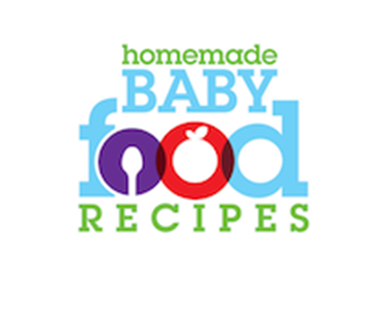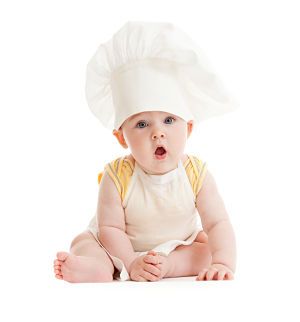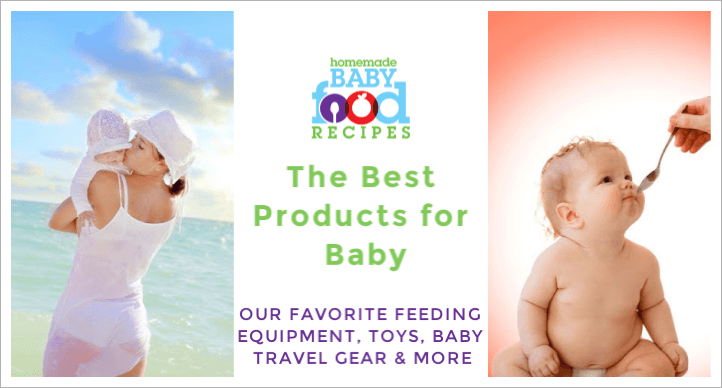Baby Food Storage And Preparation
There is no mystery to safe baby food storage and preparation. These practical guidelines will help you serve only the very best meals to your discerning wee diner.
Preparation Tips and Techniques
Hygiene in the kitchen
Cooking for baby is great fun, and by following a few basic hygiene rules, it’s also perfectly safe.
Many parents worry about the food safety implications of cooking their own baby food. After all, we’re constantly told that everything must be scrupulously sterilized, so we can become obsessed over these details.
We worry over how best to sterilize the pots and pans we use to cook the food and whether or not we need to sterilize the utensils too!
But by the time your baby is starting on solid food – probably at around 6 months of age – he may already be picking his toys up from the floor and putting them into his mouth!
It was when we watched one of our children doing this very thing, that we realized you can’t possibly keep everything in your baby’s world sterile.
We also came to the conclusion that we wouldn’t want to.
In fact, many medical professionals agree that our obsession with cleanliness can lead to a lowered immunity, making us more vulnerable to germs and disease.
Nevertheless, there ARE some simple, common sense guidelines that we need to follow to ensure the food we prepare for our baby is safe…
- Always wash your hands before you start. Yes, it sound obvious, but so many of us forget to do it!
- Make sure you wash your pots, pans and utensils in hot, soapy water. Then air-dry them, instead of using a tea towel.
- Wash vegetables and fruit with cold, running water.
- Try to use separate cutting boards, one for “animal” products like meat and fish and another for fruits, vegetables and bread. If you only have one board, wash it when you switch from one food type to another. Plastic or glass boards are best – wooden ones tend to harbour bacteria.
- Refrigerate freshly cooked baby food within 2 hours. Bacteria can grow at room temperature after this time.
Preparation methods
There are four basic cooking methods –
- steaming
- boiling
- baking
- microwaving
These are then followed by pureeing or mashing, depending on the type of food and your baby’s age.
These are all methods that you will have used to cook your own food. So the good news is that your kitchen is already well equipped to cook for baby!
The second piece of good news is that if you cook in bulk, you can prepare an entire month’s supply of food in one afternoon! This really demonstrates how we all have the time to cook our own baby food – it just takes a little organization!
So which is the best method to adopt when cooking for baby?
Well, it depends partly on which type of food you are cooking – for example, nothing is simpler than baking a sweet potato in its’ skin (see first foods recipes).
Generally speaking, though, steaming is the best way of retaining the foods’ nutrients. You can use an electric steamer, or do what we do and simply place the foods in a colander over a pan of boiling water.
If you choose to boil the food instead, then use very little water and keep any water remaining once the food has cooked. You can then use it to thin purees – that way, if any nutrients were lost into the water in the boiling process, you can incorporate them back into your baby’s food.
Microwave cooking also preserves the nutrients in the food, as foods tend to cook quickly and with little water.
Some people dislike using microwaves – if you’re one of them, then of course choose an alternative method.
As parents of five, we’ve always found the microwave useful as it makes reheating foods so simple and fast. And if you’re facing a hungry baby with a bag of frozen baby food – (yes, sometimes we multi-tasking parents will forget to defrost baby’s dinner) – then “fast” is the way to go!
Pureeing or mashing
For large quantities of food, a blender or food processor is invaluable. If you don’t have either, then you could push the food through a sieve. We find that a bit slow-going and would really recommend that you treat yourself to a time-saving appliance (you work hard – you deserve it!).
Sometimes the texture of your puree may not be quite as you’d intended! But don’t worry – just check out our great tips for both thickening and thinning your baby food purees!
Baby food storage
So now that you’ve created a batch of delicious meals for your baby, here are some ideas on how to conveniently – and safely – store them.
Refrigerator and freezer
If you’ve made only a small quantity of food, then place it into an air-tight container and store it in the refrigerator. Don’t put it in the door – the temperature is lower there. Always store baby food on the shelves.
Store larger quantities of food in the freezer. The following baby food storage chart shows the length of time that you can safely store each type of food.
Food Type |
Fridge |
Freezer |
|
Cooked fruits and vegetables |
2-3 days |
1-3 months |
|
Meat |
1 day |
1-2 months |
|
Meat & vegetable combination |
1-2 days |
3-4 months |
|
Egg yolks |
1 day |
1-2 months |
Note: Frozen foods that are kept too long may look OK, but will have lost some of their taste and nutritional value.
More refrigeration/freezing guidelines, including tips for dealing with power outages
How to freeze baby food
There are a few methods you could use …
Spoon the food into a clean ice cube tray (each cube is equivalent to about 1 oz of food). Cover the tray with clingfilm/Saran wrap, or use a tray with a lid. Don’t use foil – bits of it can remain in your baby’s food.
Once the cubes have frozen solid, empty them into separate freezer bags.
Buy the kind that allow you to write on the front, or use food labels that allow you to make a note of the date, and the type of food inside.
The date is important and helps you “rotate” the food supply, using older batches before new.
Don’t forget to write the food type – it’s hard to tell what’s what when everything’s frozen! If you discover your baby has an allergy to a certain type of food, you can easily remove all the “offending” bags.
Or you could use a special “baby food” freezer tray - you can see our top 3 storage systems here.
Another baby food storage method is to put 1-2 tbsp of pureed food in separate spots on a baking sheet, cover with clingfilm and place in the freezer. These can then be removed and put into bags, as above.
The great advantage to these baby food storage methods is that the food will take up very little space in your freezer.
How To Freeze Baby Food – our complete, step by step guide
Click here for more homemade baby food accessories, including ideal storage solutions.
Reheating the food
Each evening, select from the freezer the foods you plan to give your baby the next day. Then place them in the refrigerator to defrost (this usually takes at least 4 hours).
Fruits will not need to be warmed before use. To warm other foods, use an electric warming dish, heat the foods in a dish over boiling water, or use the microwave. In all cases, stir the food thoroughly and test it before serving it to your baby.
Always throw away any leftover reheated food.
All thawed food should be used within 48 hours, 24 hours for meat, fish or egg yolk. Freezing foods causes some cell damage, as ice crystals expand in the food. These means that previously frozen foods deteriorate more quickly than fresh.
More guidelines for heating baby food, including microwave tips
Is it dangerous to reheat rice?
And that’s all there is to it! By following this simple baby food storage and preparation advice, you can be confident that the foods you serve your baby will be safe, healthy and delicious.


